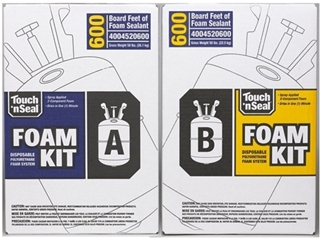
Spray foam is to your home like a cap is to a bottle of soda – keeping air from leaving and coming out, but the mysteries of spray foam don’t begin and end there. In addition to sealing air leaks (and unlike a soda cap), it also works to insulate the home. Making sure you don’t lose your head while navigating the waters of spray insulators, here are 5 things you should know about DIY spray foam insulation.
1. It’s an Insulator
Spray foam keeps your home from being uncomfortable to live in year-round (at least where temperature is concerned). Basically, it acts as an insulator by blocking cracks and gaps where air can get in or out. Installing spray foam:
- Protects your home from extreme cold in winter
- Protects your home from extreme heat in the summer
- Limits entrances for critters
2. Spray Foam Measured in Board Feet
Spray foam kits are measured in board feet, or square feet. For example:
- Spray foam insulation kits 1000 sq ft cover 1000 square feet at 1 inch thickness.
- A 600 board foot kit will cover 600 square feet at 1 inch thickness or 300 square feet at 2 inches thick
- A 200 board foot kit will cover 200 square feet at 1 inch thickness, and so on.
What makes it a smart investment is that it expands, so a little goes a long way as it expands rapidly. So to calculate how much foam you would need for your project, calculate the square footage to be covered first. Then decide on the desired thickness to achieve you desired insulation level. e.g. for closed spray foam the R Value is 7.12 per inch. If your area to be sprayed is 580 square feet and you want an R value of 14, then you would need (2) 600 board feet spray foam kits to finish your project.
3. Where You Should Use It
There are many areas where spray foam insulation can be of use, but these places make the overall top 3-5 list:
- Attics and Garages – Most attics and garages are poorly insulated areas, always either overly hot or overly cold.
- Basements – Basements fall prey to humidity, breeding mold and mildew when not properly insulated.
- Walls, Ceilings and Floors – Air leaks are at home in the cracks/gaps found in walls, ceilings and floors.
4. How to Use Spray Foam
To get an even stream of foam, the DIY spray foam “B” tank needs to be warmed up to 70 degrees Fahrenheit before use. The warming makes it the same, milky consistency of the “A” tank. Tank can be warmed by:
- Storing it in a warm room
- Covering tank with an electric blanket
- Using a tank warmer
Spraying 1″ thickness expands 30 times, so be a little conservative with spraying the foam.
Finally, always wear protective gear (goggles, gloves, disposable coverall) when completing DIY projects.
5. It Saves You Energy and Money
Spray foam protects the energy in a home from escaping and prevents outside air from breaking through, giving you – not air leaks and the gas company – control over the temperature in your home and the results of your heating bill.
Energy
Proper insulation makes it easier for the air system in your home to work the way it was intended to, preventing the need to adjust the heating/cooling system throughout the day.
Money
During winter, heating costs alone are 2% on every degree you raise the thermostat. That’s money spent on energy flying straight through all of those gaps and cracks. You can reduce your energy costs by up to 20% by using DIY spray foam and other energy efficient tools.
Ultimately, the comfort of your home and ease on the wallet make using DIY spray foam a smart, energy and cost efficient solution to your heating and cooling woes.

It really helped when you talked about spray foam and how it could help prevent mold growth. Recently, my wife and I decided to move into another house, and it came with a basement. We want to turn our basement into a games room, and we do want to keep it from mold growth, so we’ll be sure to insulate it. Thanks for the information on how basements with no insulation are prone to mold infestations.